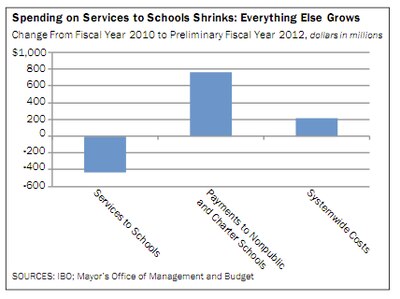
Spending going directly to schools would decrease along with the number of teachers in the city, while spending on instructional administration, transportation, and school food would all increase if Mayor Bloomberg’s proposed 2012 budget is passed.
Those are among the findings of an analysis of the mayor’s proposed 2012 budget released by the Independent Budget Office today.
The budget also calls for cutting spending on general education and special education instruction by between 1 and 2 percent and making large cuts to funds for school facilities and safety. The cuts to classroom spending include the loss of more than 6,000 teaching positions, with more than 4,600 of those positions lost through layoffs.
Meanwhile, spending on the DOE’s central administration would grow by 10 percent from this school year, though it would still be lower than it was between 2005 and 2010.
The IBO analysis also predicts that the city will have a slightly smaller surplus to roll over into next year than the Bloomberg administration has estimated, $2.9 billion compared to the mayor’s estimate of $258 million more. The surplus has attracted attention from the teachers union, which points to its existence to argue that the mayor shouldn’t have to lay off teachers.
But the analysis shows that neither surplus would be enough to use to plug the projected 2012 shortfall.
The IBO actually estimates that the city will actually still have a small shortfall of roughly $200 million in 2012 even if the city makes the dramatic cuts proposed in Bloomberg’s budget and even if the state sends the city the extra $600 million in funds it is requesting.
Although spending on services to schools is declining by $207 million, both the overall Department of Education spending and the city’s contribution to it are increasing.
That’s because the city has seen a shift in the distribution between two sets of education spending — funding that goes to district schools, on one hand, and funding that goes to charter and nonpublic schools, on the other. For the first time since at least 2007, the first pot, to district schools, is actually decreasing, but the amount sent to charter schools and nonpublic schools is rising.
The increase is driven in part by an increase in enrollment at charter schools, which the city funds based on a state formula. Other programs under this bucket include special education pre-kindergarten programs, contract schools, foster care programs and so-called “Carter Cases,” which require the city to reimburse parents for private tuition for students with special needs that public programs do not serve.
The amount of money that the Department of Education has spent on charter schools has tripled in the last four years, the report says, with funds for next year set to increase 30 percent from this year. The funding has increased because enrollment at charter schools has grown as more schools are opened and older schools grow to serve more grades.
While the number of students enrolled at city charter schools has been growing and will almost certainly continue to grow as the schools expand and more open, the report notes that the city has not seen a decline in the number of students enrolled in traditional public schools.
“Regardless of how many charter school students would otherwise have attended public schools, the fact remains that — at least for now — the public schools are being asked to educate roughly the same number of students with a reduced budget available for services to schools,” the report says.
Today’s report focuses on explaining how the mayor’s budget distributes funds and presents the office’s revenue predictions. In several weeks, the IBO will release another report offering alternate budget options that could be adopted.
Read the IBO’s full report (PDF) here .
